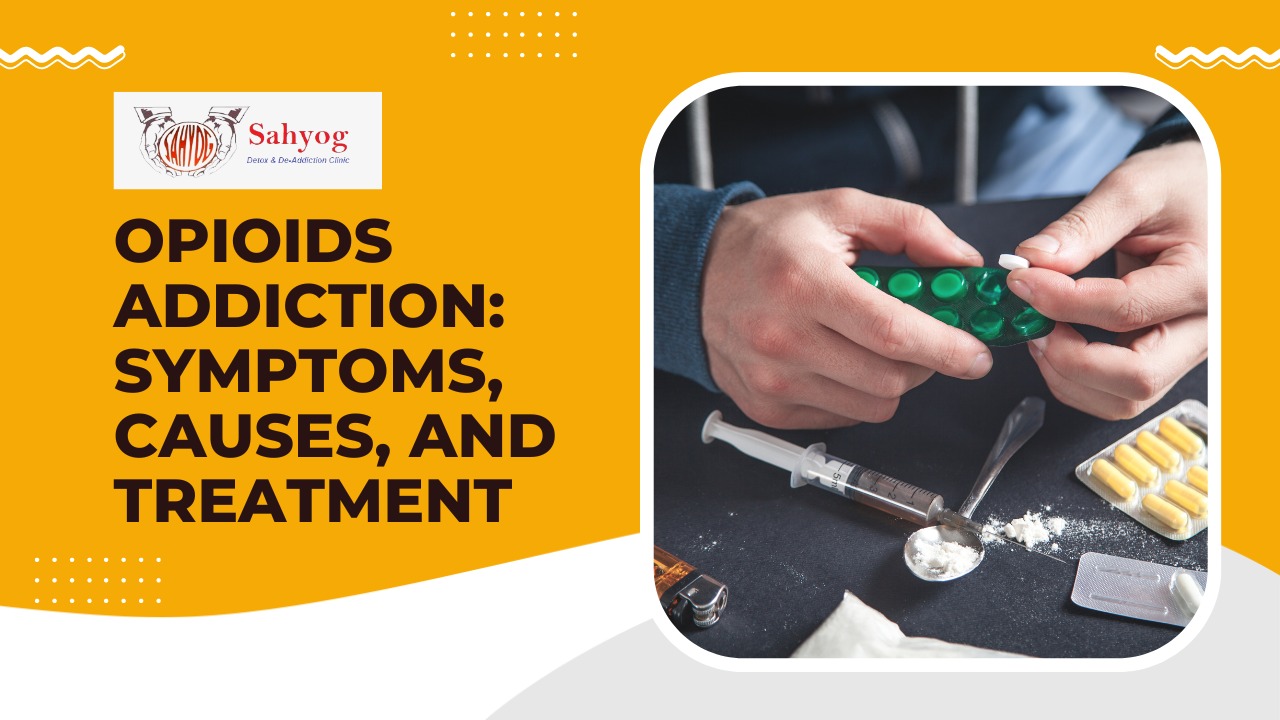Opioids Addiction: Symptoms, Causes, and Treatment
Opioids are a class of drugs that include morphine, codeine, and OxyContin. These medications are used to treat pain, but they can also be addictive and lead to abuse and opioids addiction.
In this article, we will discuss the symptoms of opioid addiction and the causes of this problem. We will also discuss the different types of treatments for opioid addiction and how successful they are.
What are Opioids?
Opioid medications are prescription medications that relieve pain. They are called opioids because they work by affecting the opioid receptors in the brain. It includes codeine, morphine, oxycodone, and fentanyl.
Opioids addiction is a serious problem. It’s one of the most common drug addictions in the United States, and it’s also one of the most deadly.
Opioids can be addictive even if you only use them for a short time. And even if you don’t get addicted to opioids, using them often can cause other problems, like:
- Bad moods
- Trouble sleeping
- Constipation
- Dry mouth
- Muscle aches
What is Opioids Addiction?
Opioids addiction is a problem with using opioids, such as morphine, codeine, and oxycodone, to manage pain. Opioid addiction happens when someone becomes so dependent on these drugs that their use affects their life negatively.
Opioid addiction commonly causes people to:
- Take opioids even when they don’t need them or can’t feel the benefits
- Compulsively take more and more of the drug to get the same effects
- Sleep whole days or nights without stopping for pain relief
- Neglect other activities in favor of taking opioids
- Use opioids even when it’s not medically appropriate or safe
Types of Opioids
Opioids are a class of medications that act on the brain and spinal cord to produce analgesia (pain relief). They are typically used to treat pain from conditions such as cancer, chronic pain, and end-of-life care. Opioids can also be used to treat other conditions, such as anxiety and depression.
The most common opioids are morphine, codeine, and oxycodone. Other opioids include hydrocodone, fentanyl, methadone, and tramadol.
Opioids can be prescribed by a doctor or obtained illegally on the street. Opioid abuse is a growing problem in the United States. In 2016, there were an estimated 2 million people living in the United States who abused opioids.
The addiction of opioids is considered a serious medical condition. It can lead to physical dependence and addiction. Opioid addiction can be treated with medication or behavioral therapies.
The Symptoms of Opioids Addiction
Opioid addiction is a debilitating condition caused by the prolonged and repeated use of prescription painkillers or illicit opioids. Opioids are a type of drug that includes drugs such as oxycodone, morphine, heroin, and fentanyl.
It can affect anyone, but it is more common in people who have chronic pain or who are receiving treatment for an injury or illness.
The signs and symptoms of opioid addiction vary depending on the person’s level of addiction. However, opioids can cause significant changes in mood, sleep, appetite, and behavior.
This addiction is considered as a relapsing syndrome because individuals may experience periods of abstinence and then relapse into continued use.
The main causes of this addiction are the drugs themselves and the way they are abused. Abusers often take opioids in greater amounts and for longer periods of time than prescribed to them to achieve an addictive state.
Opioid abuse also involves using other drugs to counteract the effects of opioids, such as alcohol or benzodiazepines.
There is no one-size-fits-all approach to treating opioid addiction. However, treatment typically includes counseling and medication to reduce cravings and symptoms of addiction. Treatment may also
Causes of Opioids Addiction
Opioid addiction is a serious and life-threatening problem that affects millions of Americans. It can develop from taking opioid medications for any reason, including to relieve pain. Opioid medications include prescription opioids, such as morphine, fentanyl, and oxycodone; and illicit opioids, such as heroin and fentanyl.
The addiction is caused by a combination of factors, including:
- Genetics: People are more likely to develop opioid addiction if they have a family history of the condition. This addiction is also more common in people who have a substance abuse disorder or mental health condition, such as depression or anxiety.
- Personal factors: Patients who use opioids regularly often have difficulty controlling their use. They may also be more likely to become addicted if they have difficulty managing stress or dealing with chronic pain.
- Environmental factors: Exposure to drugs or alcohol during development can increase the risk of developing the addiction of opioids later in life. Substance abuse also increases the risk of developing an addiction.
- Brain chemistry: The brain’s reward system – which includes dopamine and serotonin receptors – plays a role in creating a craving for opioids. Some people are more likely to develop an opioid addiction than others, due to a variation in their genetic makeup.
Treatment for Opioids Addiction
Opioid addiction can be a difficult and complex problem to treat, but the right treatment can help individuals live healthy, productive lives. There is no one-size-fits-all approach to treating this addiction, as the best approach depends on the individual and their specific circumstances.
However, many treatments for opioid addiction involve counseling, detoxification (including withdrawal management protocols), and medication therapy.
Counseling is often the first step in treatment. Counselors can help individuals learn about the causes of their addiction and how to manage it. They can also provide support during withdrawal and treatment programs.
Detoxification is an important part of any treatment program. Detoxification involves identifying and managing symptoms of withdrawal (such as cravings, sweating, nausea, vomiting, diarrhea) while gradually weaning an individual off of opioids.
Medication therapy is a common treatment for this addiction. Medications such as methadone or buprenorphine can help relieve cravings and improve moods. These medications can also help people stay abstinent from opioids long term.
Overall, treatment for this addiction is a long and difficult process. However, with the right support, individuals can overcome their addictions and live healthy, productive lives.
How to treat Opioids Addiction
There is no single cure for the addiction, but there are many treatments that can help manage the disorder. A person with this addiction may need to try different treatments to find one that works best for them.
Some common treatments for opioid addiction include:
- Behavior therapy, which teaches people how to deal with their cravings and urges
- Support groups for family and friends of people with addiction
- Medication-assisted treatment, which includes drugs like methadone and buprenorphine that help reduce cravings and withdrawal symptoms
- Treatment centers that provide a full range of services, including counseling, group therapy, and 12-step programs
Effects of Opioids
Opioid addiction is a growing problem in the United States and around the world. Opioid drugs, such as OxyContin, fentanyl, and morphine, are highly addictive and can cause severe negative effects on the body and mind.
Opioids can be prescribed for a variety of reasons, but they are often used to treat pain. However, opioid abuse can lead to dependency on the drugs, which can create a number of problems.
Here are some of the most common effects of opioid abuse:
1. Euphoria: Opioid drugs produce a sense of pleasure and euphoria that can lead users to continue using them even when they’re not needed. This can create an addiction to opioids that is difficult to break.
2. Reduced pain: Opioid drugs may initially help reduce pain, but over time they become less effective. This means that people who rely on opioids may experience increased pain instead of relief.
3. Withdrawal symptoms: When someone stops taking opioids abruptly, they may experience withdrawal symptoms including restlessness, sweating, muscle aches, diarrhea, vomiting, and seizures. These symptoms can be very severe and require professional help to manage.
Opioids Addiction and Abuse
Opioid addiction is a serious problem that can lead to death. It’s a type of addiction that’s caused by the repeated use of opioids, which are medications that are derived from opium. Opioids include prescription painkillers, such as morphine, and heroin.
Its addiction can happen when someone takes opioids for recreational purposes or for medical reasons, without getting the proper guidance from a doctor. It can also be caused by exposure to opioids in the environment.
There are many symptoms of opioid addiction, including:
- Physical dependence: When people regularly take opioids, their bodies become physically dependent on them. This means that if they stop using opioids abruptly, they will experience withdrawal symptoms, which can be intense and long-lasting.
- Tolerance: Over time, people develop an increased need for opioids in order to maintain the same level of comfort and satisfaction. This tolerance is often associated with an increased risk of relapse after quitting opioids cold turkey.
- Addiction: Once someone becomes addicted to opioids, they will continue to use them even if it causes significant harm to their health or life. Addiction is a serious condition that can require treatment.
- Death: Opioid addiction is a leading cause of death in the United States, and it’s also responsible for a large number of hospitalizations.
Conclusion
Opioids are a class of drugs that include morphine, codeine, and hydrocodone. Opioids have been widely used for many years to treat pain, but they also have addictive properties. As opioid use has increased over the past several decades, so too has addiction and overdose rates. If you or someone you know is struggling with an opioid addiction, there is help available.


